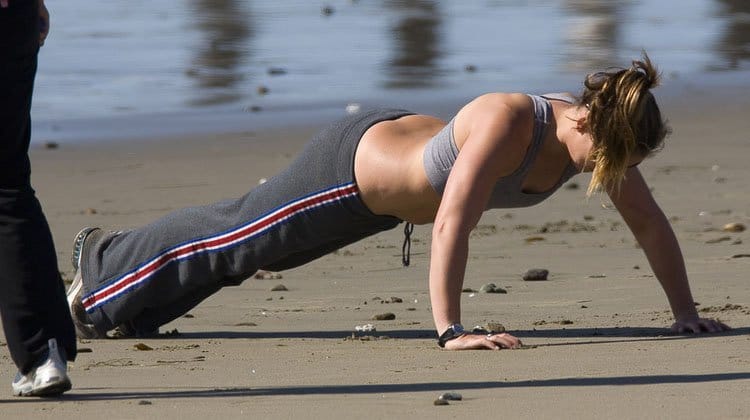Push-ups help strengthen your shoulders, arms and chest muscles. This exercise also works secondary muscles like the abs, glutes, quadriceps, lower back and deltoids.
Beginners may find it difficult to perform a standard pushup, but there are variations you can use to build strength and eventually work your way up to performing standard pushups. The basic pushup position puts your neck, back and legs in a straight line while your hands hold your body off the floor. Modified pushups will help to strengthen the muscles required to hold this position, progressively increasing your strength over a period of weeks.

Image by Mike Baird
If you are trying push-ups for the first time, start gradually. Stand against a wall and move feet away from it until your arms, chest, and back muscles feel the resistance. Try it with a countertop or chair seat before you hit the floor. Start with knee push-ups, then move on to on-toes. Modify the load in case you feel pain.
Build upper body and core strength, needed for pushups, through exercises like planks. Planks are a great sister exercise to push-ups as they complement the muscles being exercised. In fact, push-ups are a ‘just another plank variation’.
Should I Do Push-Ups?
In general, exercise is good for everyone. It seems to benefit every system of the body, and it’s one of the best ways to relieve stress.
Should you start doing push-ups? The short answer is yes! However, we must first assess what shape you’re in before jumping into exercise.
Push-ups are probably one of the oldest forms of a strengthening exercise on record. The popularity of push-ups is due to the fact that they can be done anywhere and don’t require any special equipment.
However, if an individual does not have the required strength to perform a push-up, an injury to the shoulders, elbow, wrist, neck, and lower back can occur. So, how do we determine where and how to start?
If you don’t exercise regularly, don’t assume they you can get on the floor and start doing traditional push-ups. You should “wean” into the exercise in order to determine your ability.
How To Go About It?
Start in a standing position and lean against a wall with your feet 1 to 2 feet (.3–.6 meters) away from the wall. Pretty easy, isn’t it?
In fact, it’s probably too easy, so move your feet farther away from the wall and try different distances until you feel a good resistance in your chest, arm, and back muscles.
Gradually increase the load by leaning against a countertop, chair seat, and, eventually, the floor.
Initially, you may want to begin by keeping your knees on the floor. Bring your heels up toward your buttocks, and keep your body straight. Go slow and use full range of motion, allowing your chest to gently touch the floor. By pulling your elbows closer to your sides, you can place more focus on your chest muscles.
This is now becoming quite challenging, isn’t it?
What If It Causes Pain?
If you feel pain, modify the push-up by reducing the load. You may find it necessary to not go all the way down to the floor with your chest. Stopping halfway or three-quarters down is a good option if you have shoulder problems, for example.
What To Do For Added Strength?
A push-up also strengthens the core as it’s essentially a front plank. Side planks from the knees first and then feet can be added for additional core strengthening.
A “push-up with a plus” is another modification particularly good for the scapular stabilizing muscles. Here, you push up beyond the normal “up” position as high as possible until you feel your shoulder blades (scapulae) spread apart.
Whether you’re trying to get in shape after a long winter or after pregnancy, the benefits of push-ups is you can do them anywhere and anytime. Your push-up options are almost endless!
The key to a happy life is being healthy, and exercise is key to a healthy life!

